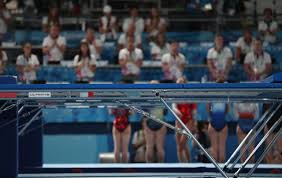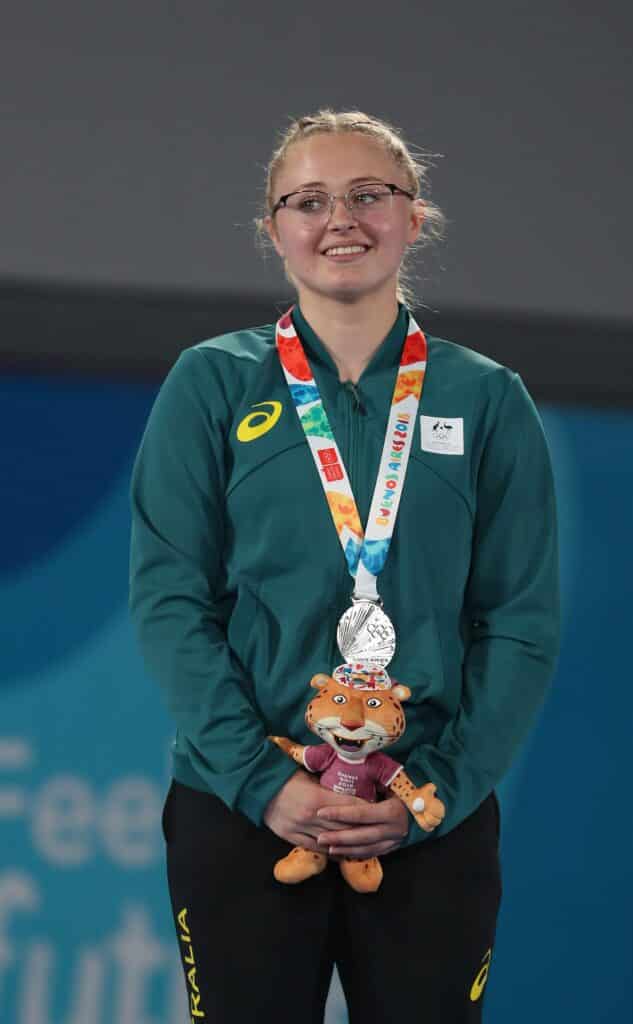Trampolining has followed a bumpy road on its quest for inclusion in the Olympic Games but since the Sydney Olympics in 2000, Trampoline has established itself as an Olympic sport. From skepticism and roadblocks to breakthrough performances, trampoline athletes have fought for decades to prove their sport deserves a spot among the highest levels of gymnastic achievement.
Their persistence ultimately paid off now that Trampoline is in the Olympics. Read on to discover the fascinating journey of Trampoline.

Early Olympic Exhibition Performances
Trampolinists first appeared at Olympic Games in the 1960s-1970s during opening ceremonies or in exhibition shows outside the competition:
- At the 1964 Tokyo Olympics, a trampoline demonstration captivated crowds as proof of concept.
- In 1972 at Munich and 1976 in Montreal, non-competing trampoline routines were included in opening ceremonies as entertainment.
While not in true competition, these showcases gave the Olympics an early taste of trampolining’s athletic appeal.
The Case for Olympic Inclusion
Through the 1970s, trampoline leaders increasingly lobbied for full medal status in the Olympics. Key arguments included:
- Trampolining was now an advanced sport requiring immense skill and fitness (3).
- It was governed by national and international federations with formal rules and rankings.
- Women were equally involved, making it a great gender-equal addition.
- It would draw interest and expand the Olympics’ gymnastic program.
But the effort faced serious hurdles.
Resistance From Gymnastics Federations
In the 1970s, trampolining’s bid for independent Olympic status was repeatedly rejected. The International Gymnastics Federation (FIG) controlled Olympic gymnastic spots and saw trampolining as a sideshow rather than a real sport.
Some in the gymnastics community looked down on trampoline athletes as less disciplined or legitimate than artistic gymnasts. They worried trampolining’s inclusion would dilute resources for more established gymnastic events.
Breakthrough as an Olympic Exhibition Sport
Trampolinists finally achieved a milestone when trampolining was approved as an Olympic exhibition sport at the 1996 Atlanta Games. For the first time, medal competitors demonstrated their skills at the highest international stage.
While not yet granted full status, this exhibition signaled trampolining could stand alongside elite gymnastic disciplines. The impressive routines on display strengthened the case for trampolining’s Olympic future.
When did Trampolining Become an Olympic Sport?
A major breakthrough came in 1998 when gymnastics’ world governing body FIG finally formed a dedicated Trampoline Technical Committee, after years of trampoline leaders’ lobbying.
This committee gained authority to guide trampolining’s rules, rankings and development. Their oversight helped demonstrate that trampolining was mature enough for full entry into the Olympic Games.

Trampoline’s Olympic Debut in Sydney
At the 2000 Sydney Olympics, trampolining made its long-awaited debut as an officially approved medal event. After decades of marginalization, trampoline athletes finally had the chance to compete for Olympic gold on the world’s biggest stage.
Legends of the sport like Alexander Moskalenko of Russia and Irina Karavaeva and Natalia Pavlova of Ukraine won the first Olympic trampoline titles, cementing themselves in history. Their triumphant performances marked trampolining’s arrival as an equal among Olympic gymnastic sports.
Trampoline’s Rising Olympic Popularity
In the 5 Olympic appearances since its debut, trampoline has cemented itself as a beloved highlight full of high-flying excitement:
- Iconic champion Irina Karavaeva demonstrated true Olympic greatness by winning 3 straight golds from 2000-2008.
- Canada’s Rosie MacLennan captured trampoline gold at both the 2012 and 2016 Games.
- In Tokyo 2020, China’s Zhu Xueying stunned as a first-time gold medalist against veteran competitors.
Trampoline routinely draws strong TV ratings and crowd enthusiasm thanks to its thrilling athletic display.

Trampolining for the Masses
Trampoline’s Olympic spotlight has fueled its popularity as a recreational activity. Backyard and gym trampolines have become commonplace, with kids dreaming of mimicking their Olympic heroes.
Trampolining is among the most participated school sports worldwide, providing an accessible introduction to inverted skills. And trampoline parks have become favorite hangout spots thanks to that enduring human desire to bounce.
While still niche compared to artistic gymnastics, competitive trampolining has grown significantly since its cautious Olympic start. Its exciting appeal looks destined to entertain Olympic crowds for decades to come.
Trampoline In The Pre-Olympic Era
Trampolining originated as a training tool and circus novelty act. But starting in the 1940s, it rapidly evolved into a formal competitive sport requiring tremendous athleticism, precision, and grace. Dedicated athletes and organizations pushed for trampolining to be recognized as an athletic endeavor in its own right, distinct from the circus traditions.
Fast forward to the present day and Trampolining has risen to become one of the most-watched Olympic sports globally.
Early Trampoline Competitions
The first trampoline competitions were humble affairs, but they marked the beginnings of a shift in perception. Small local trampoline events were held in the U.S. Midwest in the 1940s, attracting young gymnasts intrigued by the new apparatus.
In 1947, the first National Trampoline Competition was held at the University of Iowa, organized by trampoline inventor George Nissen. Early stars like Hall of Famer Woody Goss demonstrated a series of twists and somersaults that laid the foundations for competitive form.
Just two years later, trampolining took its biggest early leap when London hosted the first World Trampoline Championships in 1949. Top athletes from Europe and the U.S. vied for the first international trampoline titles, cementing it as a global competitive sport.

Developing Rules and Judging
Early trampoline competitions were mostly exhibitions judged by creativity and showmanship. But as events formalized in the 1950s, more objective scoring systems evolved.
The Universal Trampoline Society published recommendations for judging and best practices for routine construction. Difficulty scores rewarded more complex skills like triple somersaults. Execution scores assessed factors like body form, control, height and precision. Trampoline competitions started adhering to higher standards befitting an elite sport.
Notable Pioneers and Champions
Certain athletes were instrumental in developing competitive trampoline techniques and legitimacy:
- Dan Millman – Regarded as the “father of modern trampolining,” Millman won two national titles in the 1960s and performed pioneering triples and quadruple somersaults.
- Larry Griswold – A legendary coach who trained top talents starting in the 1940s and co-authored the first USA Trampoline safety handbook in 1960.
- George Nissen – The trampoline inventor remained a huge influence as a coach and leader in trampoline organizations.
- Judy Wills Cline – Won 10 consecutive national titles between 1959 and 1968, still the longest winning streak in USA trampoline history.
These individuals established competitive trampolining as requiring immense skill and dedication, worthy of respect as an athletic pursuit.
Trampoline Technique Innovations
New techniques expanded the creative possibilities of trampoline routines:
- Twisting – Athletes mastered multiple front and back twists in combination with somersaults.
- Barani – Front somersault with a half twist popularized by Denis Barani in the 1960s.
- Triffis – Back somersault with a half twist first completed in the 1960s.
- Cardiac Flip – Backflip with a full twist ending in prone position rather than feet first.
Such flourishes added complexity, variety and difficulty to routines. Points could be racked up by stringing skills together in novel sequences.
National Trampoline Organizations
Starting in the 1950s, national trampoline organizations formed to develop the sport and hold sanctioned events:
- British Trampoline Federation (1959)
- United States Trampoline Association (1960)
- Canadian Trampoline Union (1965)
- Australasian Trampoline Union (1969)
These governing bodies steadily professionalized trampolining with coach certifications, safety standards, athlete development pathways and formal international competition.
International Competitions: 1950s-1960s
International meets accelerated trampoline’s global growth and technical progress:
- At the 1956 World Championships, East Germany emerged as a new force, hinting at Cold War athletic rivalries to come.
- The 1964 Olympics in Tokyo hosted trampoline as a demonstration event, raising its international profile.
- American Wyatt Trimpe won 3 straight World Championship titles from 1961-1965 as the US dominated.
- At the 1967 Worlds, the Soviet Union signaled a challenge to US supremacy with its first international trampoline titles.
This competitive leapfrogging between nations demonstrated trampolining’s coming of age as a serious international sport.
Trampolining’s Split From Gymnastics
For many years, trampoline was governed independently from the International Gymnastics Federation (FIG) which oversees most gymnastic disciplines. Trampoline leaders long lobbied for integration into FIG as a key step toward Olympic inclusion. After years of skepticism, trampolining was finally embraced by the FIG in 1999.
In the early days, competitive trampolining was governed by national federations like USA Trampoline and the International Trampoline Federation (FIT). But the FIG, which controlled access to the Olympics, resisted accepting trampoline as a “real” gymnastic sport. They saw it as less disciplined and more for entertainment than their traditional gymnastics events.
But trampoline continued to grow in popularity and athleticism. FIT persistently made the case that trampoline deserved FIG sanctioning and a potential Olympic future. Finally, in 1998, the FIG established a Trampoline Technical Committee to formally oversee international trampoline competitions. This milestone showed that trampolining was starting to gain legitimacy in the eyes of the FIG.
The next year, FIT dissolved and merged into the FIG, bringing trampolining under direct FIG governance. This unity helped demonstrate trampolining was mature enough for the Olympics. The FIG Trampoline Technical Committee provided the needed oversight and standards.
After decades of lobbying and proving itself, trampoline finally achieved FIG acceptance. This pivotal milestone removed a huge roadblock and set trampolining on a path to its ultimate Olympic debut in 2000. Earning FIG sanctioning was a major achievement in establishing trampolining as an equal amongst gymnastics sports.
Trampolining Comes of Age
In just a few decades, trampolining rapidly transformed from a training tool and circus act to an elite Olympic Sport. Through formalization and constant innovation, trampoline pioneers proved bouncing could be taken as seriously as the most other sports. Their efforts earned trampolining recognition alongside artistic and rhythmic gymnastics, culminating in its rightful Olympic spotlight.
References
- How to Do a Back Handspring: Complete Step-by-Step GuideLearning how to do a back handspring is an exciting milestone for any gymnast. It builds confidence, agility, and forms the foundation for advanced tumbling… Read more: How to Do a Back Handspring: Complete Step-by-Step Guide
- How To Get Over a Mental Block In Gymnastics: A Complete GuideGymnastics is a sport that requires not only physical strength and skill but also mental strength. When a gymnast feels like they cannot attempt a… Read more: How To Get Over a Mental Block In Gymnastics: A Complete Guide
- The Best Leotard for Girls in 2025: What to Look ForFinding an ideal leotard for girls isn’t just about picking a dazzling design that sparkles (although it does help!). The leotard has to fit perfectly,… Read more: The Best Leotard for Girls in 2025: What to Look For
- The Best Gymnastics Shorts (Our Top Picks)The best gymnastics shorts are designed to be worn over the top of a leotard providing additional coverage around the upper legs, whilst allowing gymnasts… Read more: The Best Gymnastics Shorts (Our Top Picks)
- Decathlon Leotards – Are They Any Good?If you’re in the market for a new leotard, you may be wondering if Decathlon leotards are any good considering the low cost of their… Read more: Decathlon Leotards – Are They Any Good?
- A Complete Guide to Gymnastics Hand RipsAre you tired of dealing with painful gymnastics rips on your hands from training? Look no further – this article offers a comprehensive approach to… Read more: A Complete Guide to Gymnastics Hand Rips






